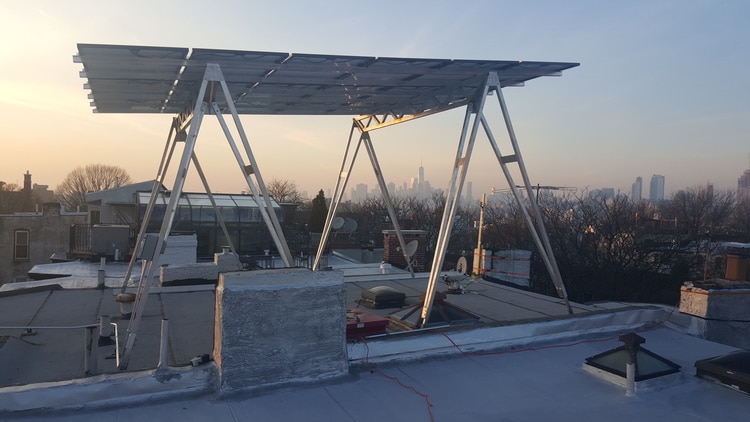By Bentham Paulos
Fifth Avenue Committee (FAC), Brooklyn’s second largest affordable housing operator, is working with solar developer Gowanus Grid & Electric to put 400 kilowatts of solar across 18 facilities in their housing portfolio. It will be enough power to supply 20 percent of the electricity needs for 281 households, cutting bills for each by about $10 per month.
The project is one of 170 teams participating in the US Department of Energy’s Solar In Your Community Challenge, a national competition aiming to expand solar electricity access to underserved segments of the population including low- and moderate-income households. The Challenge provides seed funding, technical assistance, and the chance to win $1 million in final prizes, including a grand prize of $500,000.
FAC Solar was also one of five teams named on September 25 as a partner in the NYC Housing Authority’s ACCESSolar program, which stands for “ACcelerating Community Empowered Shared Solar.”
“FAC Solar is a direct response to rising energy costs and the pressures on keeping housing affordable to low-income families in New York City,” says Michelle de la Uz, Fifth Avenue Committee’s Executive Director. “The FAC Solar project also addresses the need for environmental equity and advances our efforts to be a part of the movement for community-scale renewable energy projects.”
Developing solar on FAC’s portfolio of 46 buildings, with more than 550 units, in densely crowded Brooklyn and Queens, is a complicated undertaking.
To maximize output, the solar panels will be installed where there is room for them, rather than just where the power is needed. Some buildings can host more solar than they need to power the building, while others, due to shading, small roof space, or structural issues, can’t host enough. The main installation will be 80 kilowatts on the FAC headquarters building, with the rest spread across 20 other buildings. Three of those projects are under construction now.
Using a New York policy known as “remote” or “virtual” net metering, the FAC Solar project will be able to put the panels where they are most effective and distribute the output to the bills of tenants in FAC properties.
“New York City is a very dense built environment, and we don’t have great big farm fields to put community solar in,” says Kedin Kilgore, founder of Gowanus Grid & Electric. “That’s the challenge of this market. We have to use what’s available.”
The project chose Brooklyn Solar Works as the installation contractor, due to the company’s unique rooftop canopy design that preserves roof space, accommodates vent pipes, skylights and hatches, and meets restrictive NYC fire codes.
“To get as much solar as possible we need to get around all the obstructions,” says Kilgore. “The canopy design is much more expensive but helps us get to the capacity we need.”
While a typical installation in other markets might be between $1.90 and $2.35 per watt, Kilgore says the FAC project will cost more like $3.70. “It’s the toughest market to work in the country.”
On the other hand, New York City power prices are among the highest in the country, around 22¢ per kilowatt-hour. Even with the higher installed cost, Kilgore thinks solar will come in around 18¢ per kilowatt-hour.
Plus, the price for solar power is fixed once the system is built, since there is no fuel and very little maintenance cost. Local utility ConEd is in the process of raising residential rates by about 8% over three years, with more increases expected in the future.
The project is being financed by a 20 year, low-interest loan from a special purpose lender specializing in energy. FAC will use the loan to pay for a prepaid lease. To capture tax and depreciation benefits, an investor will own the project for about six years, delivering the power to FAC tenants for no cost through a power purchase agreement. After the benefits have been captured, FAC will buy the system for close to zero cost.
New York’s shared solar policies are critical to making it work, says Kilgore, since they allow the benefits of solar to be passed on to renters, rather than just the building owner.
“When you don’t own your home, or make much money, getting access to the savings and environmental benefits of solar is difficult,” he said. “Shared solar levels the playing field, giving families who rent their homes access to the same sustainability, resiliency and energy equality benefits enjoyed by single-family homeowners.”
The project previously received a $250,000 grant from the Citi Foundation. That grant, along with support from the Governor’s Office of Storm Recovery, will fund a solar installer training program, with curriculum developed by Solar One and run by Brooklyn Workforce Innovations. The program will graduate its second class of trained installers this month.
Bentham Paulos is a consultant working with the International City/County Management Association, which manages the Solar In Your Community Challenge under contract for the U.S. Department of Energy’s Solar Energy Technologies Office.
This content is protected by copyright and may not be reused. If you want to cooperate with us and would like to reuse some of our content, please contact: editors@pv-magazine.com.









By submitting this form you agree to pv magazine using your data for the purposes of publishing your comment.
Your personal data will only be disclosed or otherwise transmitted to third parties for the purposes of spam filtering or if this is necessary for technical maintenance of the website. Any other transfer to third parties will not take place unless this is justified on the basis of applicable data protection regulations or if pv magazine is legally obliged to do so.
You may revoke this consent at any time with effect for the future, in which case your personal data will be deleted immediately. Otherwise, your data will be deleted if pv magazine has processed your request or the purpose of data storage is fulfilled.
Further information on data privacy can be found in our Data Protection Policy.